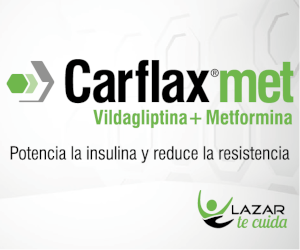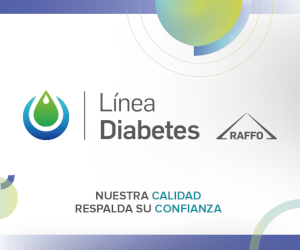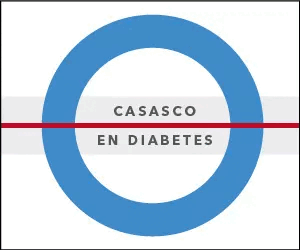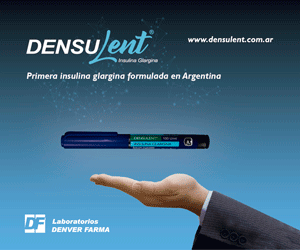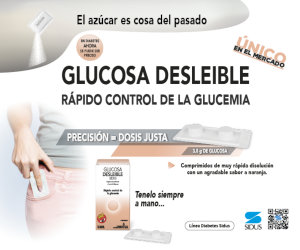Prevalence of diabetes mellitus and altered fasting blood glucose at the time of pancreatic cancer diagnosis, in a group of patients assisted in a gastroenterological referral center in Argentina
DOI:
https://doi.org/10.47196/diab.v55i1.471Keywords:
diabetes mellitus, ductal adenocarcinoma of the pancreas, impaired fasting blood glucose, prevalenceAbstract
Introduction: diabetes mellitus (DM) is considered to be a risk factor for the development of pancreatic ductal adenocarcinoma (PDAC).
Objectives: describe the prevalence of DM and of impaired fasting glucose (IFG) at the diagnosis of PDAC, among patients assisted in a gastroenterological reference center. Analyze differences in personal and nutritional characteristics in patients with both PDAC and DM; with both PDAC and IFG; and with PDAC but neither DM nor IFG. Determine the time lapse between the diagnosis of DM and the diagnosis of PDAC.
Materials and methods: between October 2019 and March 2020, we analyzed 465 clinical records of PDAC-diagnosed patients over 18 years, from Oncology and Nutrition Sections.
Results: 171 clinical records (36.7%) showed both PDAC and DM; 294 clinical records (63.2%) showed PDAC but not DM. In 45.1% of the former, the interval between the diagnosis of DM and that of PDAC was <1 year, and in 17.65%, 15.69% and 21.57%, the lapses corresponded to 1 and 5 years, between 5 and 10 years y >10 years, respectively.
Conclusions: the prevalence of DM in ACDP was higher than that registered in the general population (37% vs 12.7%), being 45.10% when it presented within the first year of oncological diagnosis. Our results agree with the international bibliography that relates recently diagnosed DM as a factor associated with the presence of ACDP due to shared risk factors, physiopathological variables of DM or as a consequence of its pharmacological therapy.
References
I. Instituto Nacional de Estadística y Censos. Secretaría de Gobierno de la Salud. Cuarta Encuesta Nacional de Factores de Riesgo: resultados preliminares. 1º Ed. Ciudad Autónoma de Buenos Aires, 2019. Libro digital, PDF Archivo Digital. Indicadores de Salud. 2. Calidad de la Atención de Salud .3. Acceso a la Salud. I. Título. CDD 613. Disponible en: https://www.indec.gob.ar/ftp/cuadros/publicaciones/enfr_2018_resultados_preliminares.pdf.
II. Ballesteros I, Abriata MG. Análisis de situación de salud por cáncer. Argentina, 2018. Instituto Nacional del Cáncer. Ministerio de Salud. Boletín de vigilancia epidemiológica. Disponible en: http://www.msal.gob.ar/images/stories/bes/graficos/0000001386cnt-20181213-boletin-epidemiologia.pdf.
III. Hezel AF, Kimmelman AC, Stanger BZ, Bardeesy N, Depinho RA. Genetics and biology of pancreatic ductal adenocarcinoma. Genes Dev 2006; 20 (10):1218-49.
IV. World Cancer Research Fund/American Institute for Cancer Research. Food, nutrition, physical activity, and the prevention of cancer: a global perspective. Washington, DC: AICR, 2007. Disponible en: https://discovery.ucl.ac.uk/id/eprint/4841/1/4841.pdf
V. Heidemann C, Boeing H, Pischon T, Nôthlings U, Joost HG, SAchulze MB. Association of a diabetes risk score with risk of myocardial infarction, stroke, specific types of cancer, and mortality: a prospective study in the European Prospective Investigation into Cancer and Nutrition (EPIC)-Potsdam cohort. Eur J Epidemiol 2009; 24 (6): 281-8.
VI. Ben Q, Cai Q, Li Z, Yuan Z, Deng S, Wang K. The relationship between newonset diabetes mellitus and pancreatic cancer risk: A case-control study. Eur J Cáncer 2011; 48:248-54.
VII. El-Serag HB, Hampel H, Javadi F. The association between diabetes and hepatocellular carcinoma: a systematic review of epidemiologic evidence. Clin Gastroenterol Hepatol 2006; 4 (3): 369-80.
VIII. American Diabetes Association. Comprehensive medical evaluation and assessment of comorbidities: Standards of Medical Care in Diabetes 2019. Diabetes Care 2019; 42(Supp 1): S34-S45.
IX. Andersen D, Korc M, Petersen G, Eibl G, Li D. Diabetes, pancreatogenic diabetes, and pancreatic cancer. Diabetes 2017; 66:1103-10.
X. Li D, Tang H, Hassan M., Holly E, Bracci P, Silverman T. Diabetes and risk of pancreatic cancer: a pooled analysis of three large case-control studies. Cancer Causes Control 2011; 22 (2):189-97.
XI. Aggarwal G, Kamada P, Chari ST. Prevalence of diabetes mellitus in pancreatic cancer compared to common cancers. Pancreas 2013; 42: 198-201.
XII. Chari ST, Leibson CL, Rabe KG, Ransom J, De Andrade M, Petersen GM. Probability of pancreatic cancer following diabetes: a population-based study. Gastroenterology 2005; 129:504-511.
XIII. Sharma A, Kandlakunta H, Singh Nagpal SJ, Ziding F, Hoos W, Petersen GM, et al. Model to determine risk of pancreatic cancer in patients with new-onset diabetes. Gastroenterology 2018; 155 (3):730-739.
XIV. Aggarwal G, Kamada P, Chari ST. Prevalence of diabetes mellitus in pancreatic cancer compared to common cancers. Pancreas. 2013; 42: 198-201.
XV. Siegel RL, Miller KD, Jemal A. Cancer statistics, 2016. CA Cancer J Clin 2016; 66:7-30.
XVI. Saad AM, Turk T, Al-Husseini MJ, Abdel-Rahman O. Trends in pancreatic adenocarcinoma incidence and mortality in the United States in the last four decades; a SEER-based study. BMC Cancer 2018; 18:688-98.
XVII. McGuigan A, Kelly P, Turkington RC, Jones C, Coleman HG, McCain RS. Pancreatic cancer: A review of clinical diagnosis, epidemiology, treatment and outcomes. World J Gastroenterol 2018; 24 (43):4846-4861.
XVIII. International Agency for Research on Cancer. World Health Organization. Global Cancer Observatory 2018. Disponible en: http://gco.iarc.fr/.
XIX. Midha S, Chawla S, Garg PK. Modifiable and non-modifiable risk factors for pancreatic cancer: A review. Cancer Lett 2016; 381:269-277.
XX. Hruban RH, Canto MI, Goggins M, Schulick R, Klein AP. Update on familiar pancreatic cancer. Adv Surg 2010; 44:293-311.
XXI. Everhart J, Wright D. Diabetes mellitus as a risk factor for pancreatic cancer. A meta-analysis. JAMA 1995; 273:1605-9.
XXII. Huxley R, Ansary-Moghaddam A, Berrington de Gonzalez A, Barzi F, Woodward M. Type-II diabetes and pancreatic cancer: a meta-analysis of 36 studies. British Journal of Cancer 2005; 92:2076-83.
XXIII. Ben Q, Xu M, Ning X, Liu J, Hong S, Huang W, et al. Diabetes mellitus and risk of pancreatic cancer: A meta-analysis of cohort studies. European Journal of Cancer 2011; 47:1928-37.
XXIV. Li D, Tang H, Hassan M, Holly E, Bracci P, Silverman T. Diabetes and risk of pancreatic cancer: a pooled analysis of three large case control studies. Cancer Causes Control 2011; 22(2):189-97.
XXV. Sadr-Azodi O, Gudbjörnsdottir S, Ljung R. Pattern of increasing HbA1c levels in patients with diabetes mellitus before clinical detection of pancreatic cancer a population based nationwide case-control study. Acta Oncol 2015; 54 (7): 986-92.
XXVI. Pothuraju R, Rachagani S, Junker WM, Chaudhary S, Saraswathi V, Kaur S et al. Pancreatic cancer associated with obesity and diabetes: an alternative approach for its targeting. Journal of Experimental & Clinical Cancer Research 2018; 37:319-33.
XXVII. Isaksson B, Strommer L, Friess H, Buchler MW, Herrington MK, Wang F, et al. Impaired insulin action on phosphatidylinositol 3-kinase activity and glucose transport in skeletal muscle of pancreatic cancer patients. Pancreas 2003; 26 (2):173-7.
Downloads
Published
How to Cite
Issue
Section
License
Copyright (c) 2021 on behalf of the authors. Reproduction rights: Argentine Diabetes Society

This work is licensed under a Creative Commons Attribution-NonCommercial-NoDerivatives 4.0 International License.
Dirección Nacional de Derecho de Autor, Exp. N° 5.333.129. Instituto Nacional de la Propiedad Industrial, Marca «Revista de la Sociedad Argentina de Diabetes - Asociación Civil» N° de concesión 2.605.405 y N° de disposición 1.404/13.
La Revista de la SAD está licenciada bajo Licencia Creative Commons Atribución – No Comercial – Sin Obra Derivada 4.0 Internacional.
Por otra parte, la Revista SAD permite que los autores mantengan los derechos de autor sin restricciones.













